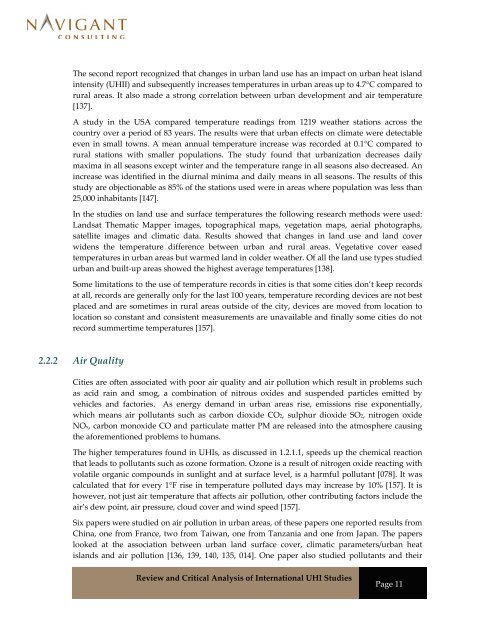Review and Critical Analysis of International UHI Studies
Review and Critical Analysis of International UHI Studies
Review and Critical Analysis of International UHI Studies
You also want an ePaper? Increase the reach of your titles
YUMPU automatically turns print PDFs into web optimized ePapers that Google loves.
The second report recognized that changes in urban l<strong>and</strong> use has an impact on urban heat isl<strong>and</strong><br />
intensity (<strong>UHI</strong>I) <strong>and</strong> subsequently increases temperatures in urban areas up to 4.7°C compared to<br />
rural areas. It also made a strong correlation between urban development <strong>and</strong> air temperature<br />
[137].<br />
A study in the USA compared temperature readings from 1219 weather stations across the<br />
country over a period <strong>of</strong> 83 years. The results were that urban effects on climate were detectable<br />
even in small towns. A mean annual temperature increase was recorded at 0.1°C compared to<br />
rural stations with smaller populations. The study found that urbanization decreases daily<br />
maxima in all seasons except winter <strong>and</strong> the temperature range in all seasons also decreased. An<br />
increase was identified in the diurnal minima <strong>and</strong> daily means in all seasons. The results <strong>of</strong> this<br />
study are objectionable as 85% <strong>of</strong> the stations used were in areas where population was less than<br />
25,000 inhabitants [147].<br />
In the studies on l<strong>and</strong> use <strong>and</strong> surface temperatures the following research methods were used:<br />
L<strong>and</strong>sat Thematic Mapper images, topographical maps, vegetation maps, aerial photographs,<br />
satellite images <strong>and</strong> climatic data. Results showed that changes in l<strong>and</strong> use <strong>and</strong> l<strong>and</strong> cover<br />
widens the temperature difference between urban <strong>and</strong> rural areas. Vegetative cover eased<br />
temperatures in urban areas but warmed l<strong>and</strong> in colder weather. Of all the l<strong>and</strong> use types studied<br />
urban <strong>and</strong> built‐up areas showed the highest average temperatures [138].<br />
Some limitations to the use <strong>of</strong> temperature records in cities is that some cities don’t keep records<br />
at all, records are generally only for the last 100 years, temperature recording devices are not best<br />
placed <strong>and</strong> are sometimes in rural areas outside <strong>of</strong> the city, devices are moved from location to<br />
location so constant <strong>and</strong> consistent measurements are unavailable <strong>and</strong> finally some cities do not<br />
record summertime temperatures [157].<br />
2.2.2 Air Quality<br />
Cities are <strong>of</strong>ten associated with poor air quality <strong>and</strong> air pollution which result in problems such<br />
as acid rain <strong>and</strong> smog, a combination <strong>of</strong> nitrous oxides <strong>and</strong> suspended particles emitted by<br />
vehicles <strong>and</strong> factories. As energy dem<strong>and</strong> in urban areas rise, emissions rise exponentially,<br />
which means air pollutants such as carbon dioxide CO2, sulphur dioxide SO2, nitrogen oxide<br />
NOx, carbon monoxide CO <strong>and</strong> particulate matter PM are released into the atmosphere causing<br />
the aforementioned problems to humans.<br />
The higher temperatures found in <strong>UHI</strong>s, as discussed in 1.2.1.1, speeds up the chemical reaction<br />
that leads to pollutants such as ozone formation. Ozone is a result <strong>of</strong> nitrogen oxide reacting with<br />
volatile organic compounds in sunlight <strong>and</strong> at surface level, is a harmful pollutant [078]. It was<br />
calculated that for every 1°F rise in temperature polluted days may increase by 10% [157]. It is<br />
however, not just air temperature that affects air pollution, other contributing factors include the<br />
air’s dew point, air pressure, cloud cover <strong>and</strong> wind speed [157].<br />
Six papers were studied on air pollution in urban areas, <strong>of</strong> these papers one reported results from<br />
China, one from France, two from Taiwan, one from Tanzania <strong>and</strong> one from Japan. The papers<br />
looked at the association between urban l<strong>and</strong> surface cover, climatic parameters/urban heat<br />
isl<strong>and</strong>s <strong>and</strong> air pollution [136, 139, 140, 135, 014]. One paper also studied pollutants <strong>and</strong> their<br />
<strong>Review</strong> <strong>and</strong> <strong>Critical</strong> <strong>Analysis</strong> <strong>of</strong> <strong>International</strong> <strong>UHI</strong> <strong>Studies</strong><br />
Page 11


